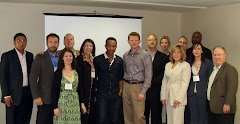
MarketBridge Exec Shares Insights
From Sales Effectiveness Study
When companies gather around the conference room table to formulate their growth strategy for the coming year, the conversation typically begins and ends with a focus on new customers and new products.
What is typically overlooked, however, is the fact that the biggest opportunities for most firms actually exist with their current clients. Scott Gillum, Senior Vice President of MarketBridge, shared insights into this issue during the recent CMO Club dinner in NYC.
In its 2007 Sales Effectiveness survey, MarketBridge found a significant disconnect between the growth plan and the feedback these companies are actually receiving from the market.
For example, the survey of just under 200 marketing and sales executives showed that “new product/extensions” and “change focus on customer/segments” were the top two selections for growth strategies, at 76% and 62% respectively. However, when asked about their customers’ biggest demands, the same respondents ranked “better products” and “better service & support” as the top 2 priorities, ahead of “new products” or “better price/value.”
Since it is typically 7 times more expensive to acquire a new customer versus retaining one, Gillum pointed out that many companies are better served by focusing more time and resources on greater account penetration.
Gillum pointed out that the disparity between what the market is asking for and the strategies most companies are adopting is driven by the fact that competitors are also knocking at the door of their clients and prospects. According to the survey, “greater competition” was cited as the top factor impacting performance, significantly ahead of organization or management changes or major product changes.
While expanding the product portfolio is a reasonable strategy for reacting to competitive pressures, the majority of survey respondents admitted their organizations were not well prepared to deal with the execution of new solutions. For example, when asked about the biggest challenges to their sales strategy, 58% said “implementing strategy” was the largest obstacle. Compounding this issue, more than a third (34%) of respondents said they were only “somewhat prepared” to deliver on their customers biggest demands. Gillum said an underlying problem with the rush to introduce “new” is that most sales forces are still not prepared for the solution selling approach required to penetrate deeper into an organization. The survey supported this theory, as more than half (51%) of the respondents cited “selling a solution” as one the greatest growth obstacles.
“Competitive pressures have forced a lot of companies to rush ahead with new solutions and new marketing messages,” Gillum said. “Unfortunately, they are not taking the first steps to educate their sales force and create alignment throughout the organization around their message. Based on what we have seen, the more successful companies are making sure they are doing the old really well before focusing on the new.”
Going Deep
Considering that most industries have seen their largest customers account for a larger slice of their business in recent years, Gillum argued that the 80/20 rule should be the top driver for growth. “If you are an established company that has been in business for 10 years or more, you can achieve your revenue and profit objectives solely based on doing a better job of capturing the opportunity in existing accounts.”
MarketBridge has worked with clients such as IBM, MasterCard, Merck, SAP and Siemens, on all stages of sales and marketing from strategy to execution. Consistently, across different size firms and various vertical markets, Gillum said the company’s work has shown that “new does not necessarily mean better.”
Since it is typically 7 times more expensive to acquire a new customer versus retaining one, Gillum pointed out that many companies are better served by focusing more time and resources on greater account penetration. “Building, selling and thinking new typically takes too long, costs too much and will have the lowest ROI. Most companies should focus first on getting more out of existing clients, and then investing in new.”
For the organizations that have shifted gears and are focusing more on building their business with top clients, Gillum said it has also required a change in their approach to marketing as well. “The first step is building a true single view of your customers so that you can look at penetration rates for different products and have better intelligence about other solutions they may need,” he said. “Once you have that, then marketing organizations are able to send targeted offers to specific segments of the client base.”
Many leading edge companies have established integrated marketing teams focused on creating sales enablement tools designed to help move prospects through to the next stage of the pipeline.
“We are now seeing a lot of people come into marketing with experience in either the product or sales side, so they have more familiarity with the sales process,” Gillum says. “These teams help them build tools that will provide more intelligence on a prospect. For example, a CRM system may tell you where a customer is in the pipeline, but it will not be able to tell you the reasons whey they aren’t moving from one stage to the next.”
While it’s crucial to formulate and implement strategies to reel in new customers, Gillum added, it is not as critical, nor as cost effective, as mining your most valuable assets—your current customers. “Learn as much as you can about your customers and how they are using your current products,” said Gillum. “Find out where their sweet spots are in terms of other offers and solutions, and then target them specifically.”







No comments:
Post a Comment